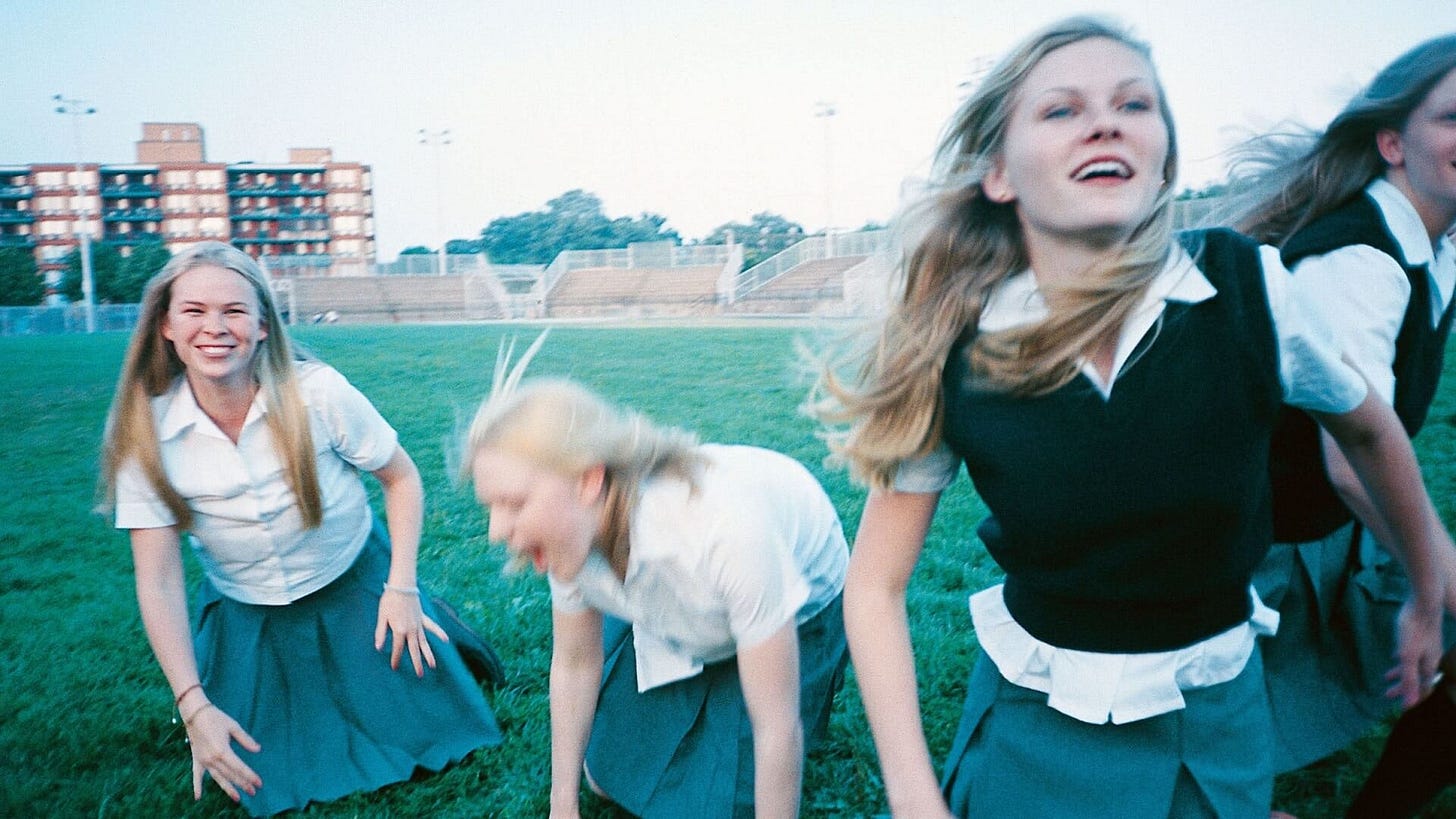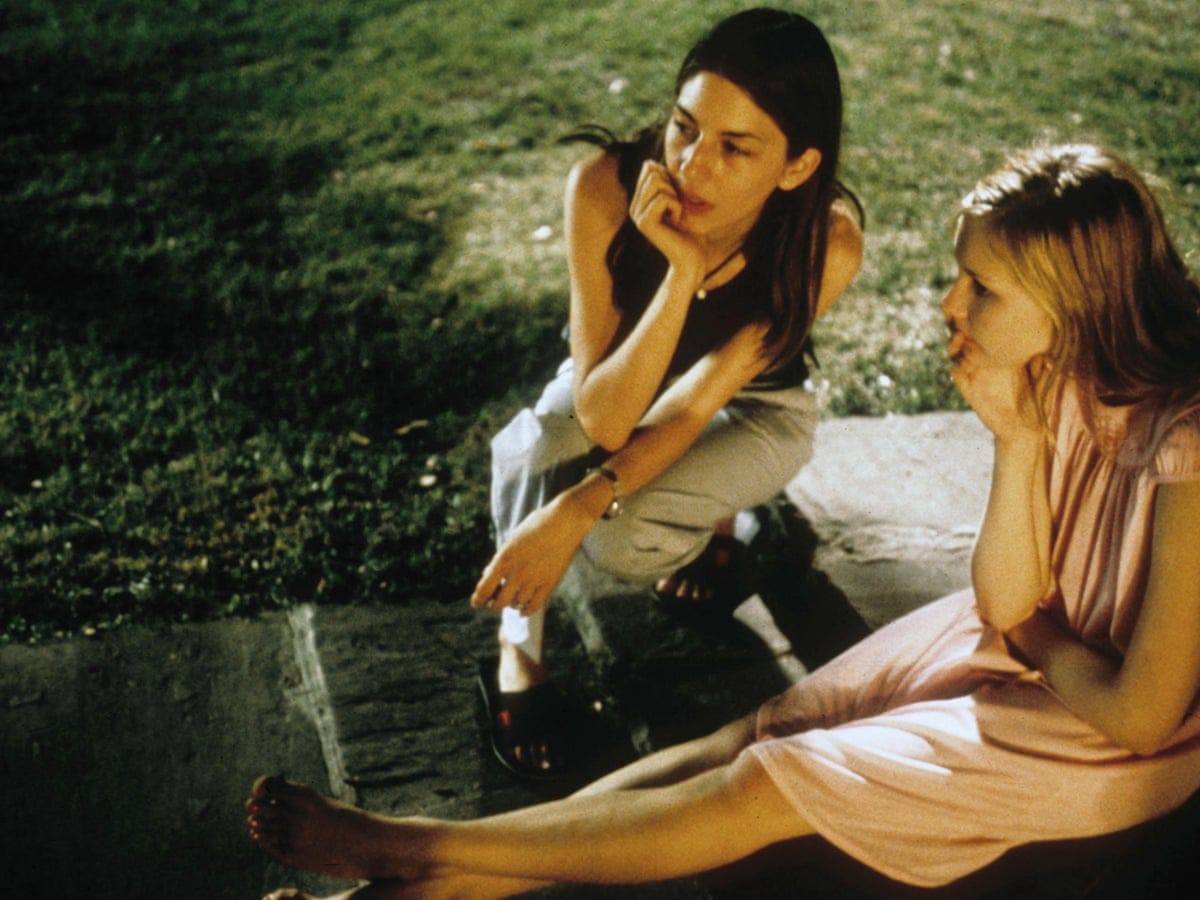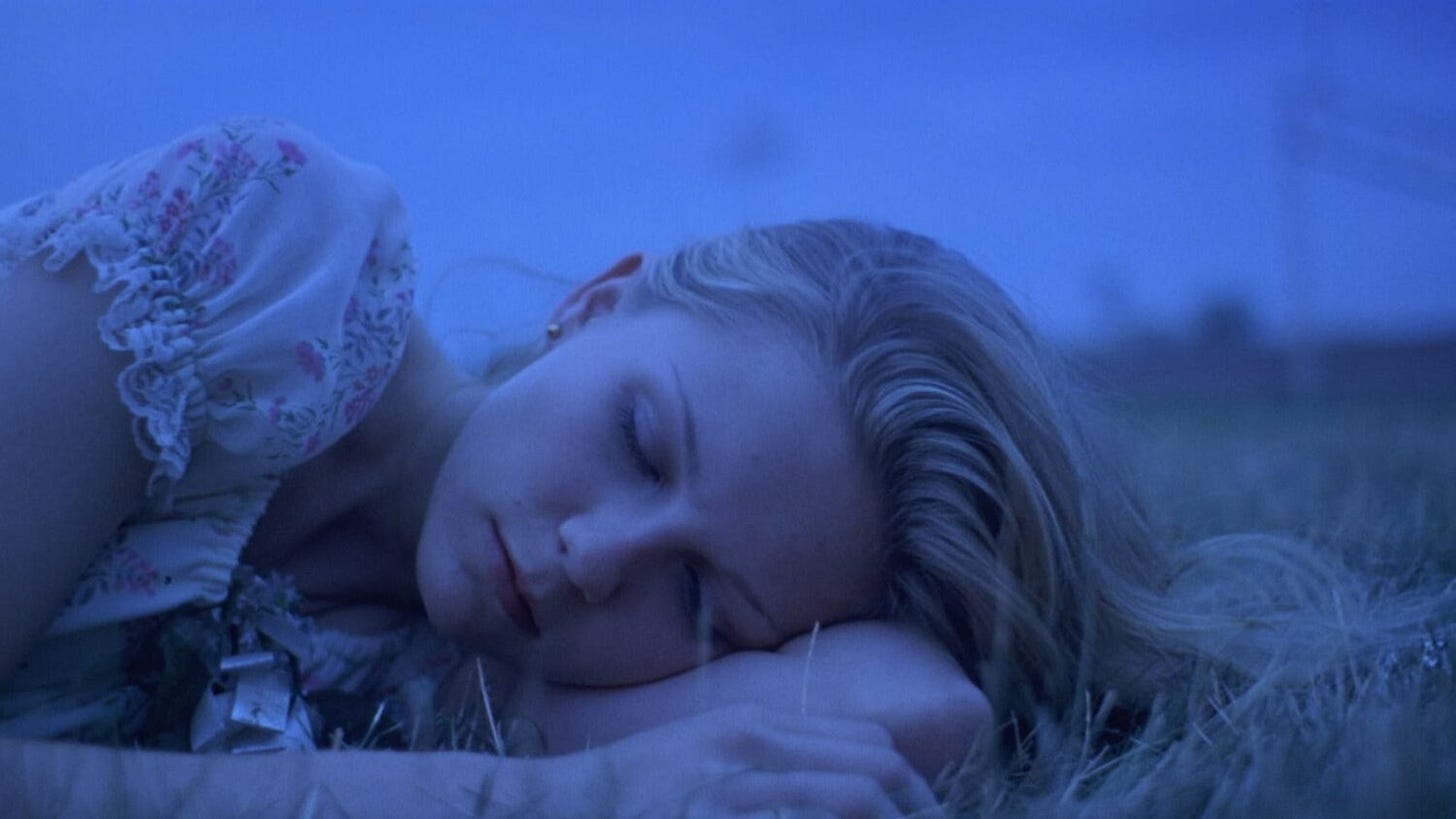Obviously Doctor, you've never been a thirteen-year-old girl.
A conversation about Jeffery Eugenides, Sofia Coppola, and the harrowing experience of being a teenage girl.
Warning: This post contains topics on suicide, please take care in reading. Spoilers ahead.
“The Lisbon girls were thirteen (Cecilia), and fourteen (Lux), and fifteen (Bonnie), and sixteen (Mary), and seventeen (Therese).”
I cannot stop thinking about dying. I have always imagined my death, ever since I was a pubescent girl. When I was eight years old, I dreamed about finding a dead woman behind a trash can. That night, I woke up in a cold sweat, soaking my Barbie pajama dress and being plagued with this vague anxiety that the corpse behind the trash can was somehow me — translucent skin, naked, cold — I want my death to be in my control if I could help it. Let me be clear: I do not fear death. I learned a little too much, a little too early in life, and I was able to accept that everyone I love would soon be dead which caused me to fantasize about my death.
During baths, I held my breath under the water to see how it felt to drown. I ran across the street when I saw a car coming to see what being hit would feel like — the man driving the car stopped in time, but not before making some impact. He did hit me hard enough that I lost my balance and dropped my Slurpee (this caused more damage than anything else), the man asked if I was okay and then sped off. I tried to kill myself, twice. Once out of deep melancholy, the other was out of sheer boredom; neither time was successful. I often thought about what my body would hitting the pavement, or what it would feel like jumping off the Coronado Bridge.
My obsession with death consumes me: I have wanted to die for over half my life.
"What are you doing here, honey? You're not even old enough to know how bad life gets."
In 1993, Jeffrey Eudigenes’ debut novel The Virgin Suicides was published. This was the same year that Bill Clinton was inaugurated as the 42nd U.S. president, the first attack on the World Trade Center was carried out, blueberries were only 99 cents, and it was the year I was born. Six years later, Sofia Coppola released her film adaptation, and six years after that, I watched the movie — the same age as Cecilia, “the first to go.” I thought about the five Lisbon sisters in their messy bedrooms, dressed with soft silhouettes, and the secrets they all held. I was obsessed with ditsy floral dresses, and soft pinks, taking an interest in dressing like them. I was dissatisfied when all my efforts to be like Lux, a “stone-cold fox,” were proven to highlight the stark reality: I was a child playing dress up. But, I was particularly fascinated with how young girls were stricken with such sadness, that they all killed themselves before they turned eighteen. It felt like finally, at my young age, I can relate to the cavernous melancholy that went beyond the perimeter of being a teenage girl — this sadness is something I now believe all women suffer; as though we are afflicted with grief the minute we are conceived.
In the early 2010s, Coppola’s adaptation was circulating Tumblr, making its way to a new aesthetic of the coquette-Lana Del Rey-Mental Illness is cool-period. Netflix had its hand in what impressionable girls idolized. There were stills of Cecilia in the bathtub, quotes from the book, and gifs of the opening title. This prompted me to read the book at 16 years old and fall back in love with these waif-like, blonde-haired girls, who knew too much and felt too much. I saw myself in them, once again, and I even made believe that these amorphous figures were me and my four sisters.
We could never understand why the girls cared so much about being mature, or why they felt compelled to compliment each other, but sometimes, after one of us had read a long portion of the diary out loud, we had to fight back the urge to hug one another or tell each other how pretty we were.
The story takes place in a 1970s Detroit suburban neighborhood, and in my teenage years, I grew up in a suburban town in San Diego. Though not quite the same, the residential scenery felt so similar to mine: gossiping neighbors, quiet streets, and big trees. I read the book as if I was narrating it myself and not the group of five boys longing for the Lisbon sisters.
The boys lust for and apotheosize the sisters, which only kept them further away from them. Filled with so much love, but always at a distance. The boys learn about the girls through watching them, reading journals, and talking to people who once knew them in the past. Years later, the group of boys narrates the story as men, still completely enamored with the Lisbon household, still completely memorializing their existence.
This is why the book and the film work so much: the sisters are seen through a sorrowful yet ardor lens of the youth. Yes, the book is a lot harsh on the girls’ looks; making comments about weight gain, bleaching mustaches, and of course, Trip Fontaine saying the reason he left Lux the night of the dance was because she was annoying. However, I stand by these comments being made because they were coming from the gaze and thoughts of teenage boys. On the same hand, Sofia Coppola chose to leave the comments out and even had Trip explain his leaving Lux to a mere “I don’t know” — to me, this decision showcases the vulnerability of the men in the movie.
Coppola also had a way of introducing depth to a scene through the colors she chooses. During the opening scene, the suburban neighborhood is warm, despite the crowd of people gathering around the Lisbon household which some people might assume is shock (I take it as purely wanting on in the gossip). Within the Lisbon household, however, Cecilia is shown in bloody water and the scene is in cool tones.
The cool tones are present throughout the movie: Lux wakes up in the field alone when we visit Trip in the Rehab center (the windows behind him are shining blue, but the shirt and building he’s in are warm; something that we see often when Lux and Trip interact. The blue represents the bleak moments the girls have and the sadness within them. Coppola uses other colors, which you can read about in this quick article by Film School Reject if you want to learn more about the color codes. I focus on the warm and blues because they stand out the most between the mundane suburban life and the young American girls who inhabit the streets.
Both the movie and book are just out of reach of the girls’ inner dwellings — who is more secretive than a teenage girl undergoing internal struggles? As a reader and a viewer, we never understand why the girls did what they did, we never get a clear insight even after the conversations the boys had with the adults in their neighborhood and with each other.
We couldn't imagine the emptiness of a creature who put a razor to her wrists and opened her veins, the emptiness, and the calm.”
To me, the lack of answers is what makes The Virgin Suicides an impactful story, even after all these years. The group of boys and the viewers never fully get to access the girls the way we want. It’s why, thirty years later, I’m still so moved by the story and why the boys cannot let them go, why Trip still loves Lux, and why the town still speaks about the girls. Both The Virgin Suicides and I turn thirty this year, I have grown a soft belly and thinning hair, just as the narrators have, still hoping that maybe the girls, therein, myself, could be saved. That the drive down the road truly happened, instead of the cruel reality that the girls all died the very night the boys went over to save them. But the girls never wanted that. They wanted it to be tragic, they needed it to be. The boys loved them, truly loved them but the girls never saw it, the girls never cared.
It didn't matter in the end how old they had been, or that they were girls, but only that we had loved them, and that they hadn't heard us calling, still do not hear us, up here in the tree house, with our thinning hair and soft bellies, calling them out of those rooms where they went to be alone for all time, alone in suicide, which is deeper than death, and where we will never find the pieces to put them back together.
Part of me wonders if they just waited another year, waited to feel loved, would they have done this? Would they have let life touch them? Maybe the girls were just full of melancholy, maybe it was teenage angst, maybe the girls truly wanted to die, or maybe they didn’t want to die, “[they] just wanted out of that house.”
-A.








